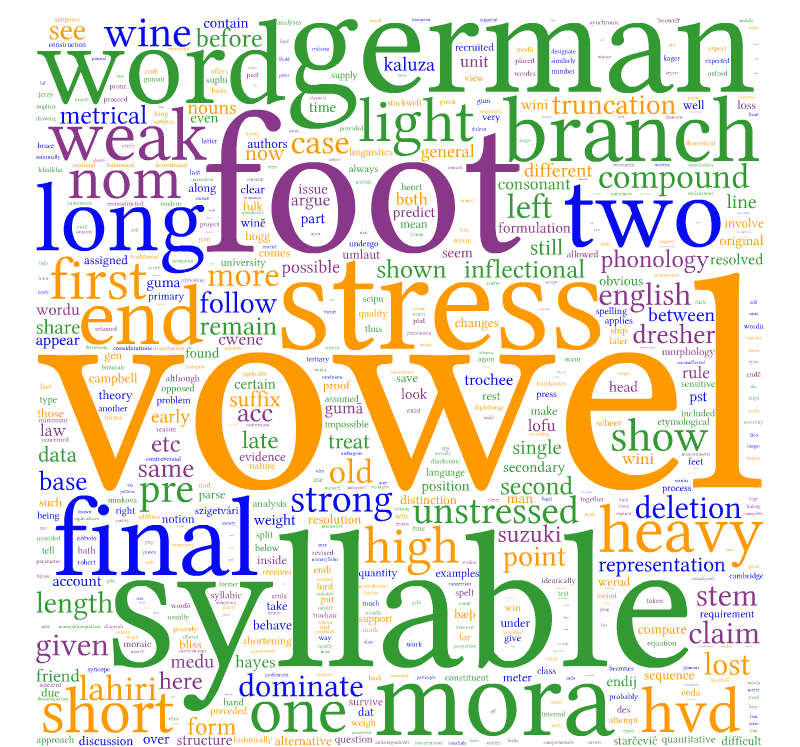
This article will look at some Old English (OE) phonological and morphological phenomena using a traditional foot-based approach (Dresher & Lahiri 1991) and concentrate on some of its shortcomings drawing on the evidence of OE compounding. My purpose is not so much to give an account of the data in an alternative theoretical framework than shed light on some of the contentious aspects presented by a foot-based approach.
I focus on the quantitative differences of word-final vowels of OE and how much information we can glean from compounding. With OE being a dead language, it is very difficult to experience the excitement of “hands on” experience with something as elusive as vowel length in unstressed syllables. Luckily, we have ample of written data from manuscripts of all sorts of extraction, as well as etymological considerations, but we have to be aware that vowel length is rarely ever shown, even less so in unstressed syllables. This is not a unique feature of Old English texts. Many modern languages do not mark vowel length in their orthography. With modern languages we have at least the chance of “hearing” a long vowel. How we analyse a long vowel is an altogether different question. Admittedly, with OE this excitement remains, by necessity, restricted to supplying diacritic marks based on some aspect of analysis (especially on top of unstressed vowels that are spelt identically): e.g., winĕ ‘friend’ vs. heortē ‘heart’. (Parts of this article appeared in Starčević 2009).
Dresher & Lahiri (1991) devise the notion of the Germanic foot and provide a comprehensive account of a number of OE phenomena, including High Vowel Deletion (HVD) and stress. The Germanic foot, they argue, is an unbalanced moraic trochee and constitutes an additional type in the general inventory of feet. The Germanic foot and HVD are defined by Dresher & Lahiri (1991: 255) as shown in (1) and (2) below.
| a. | 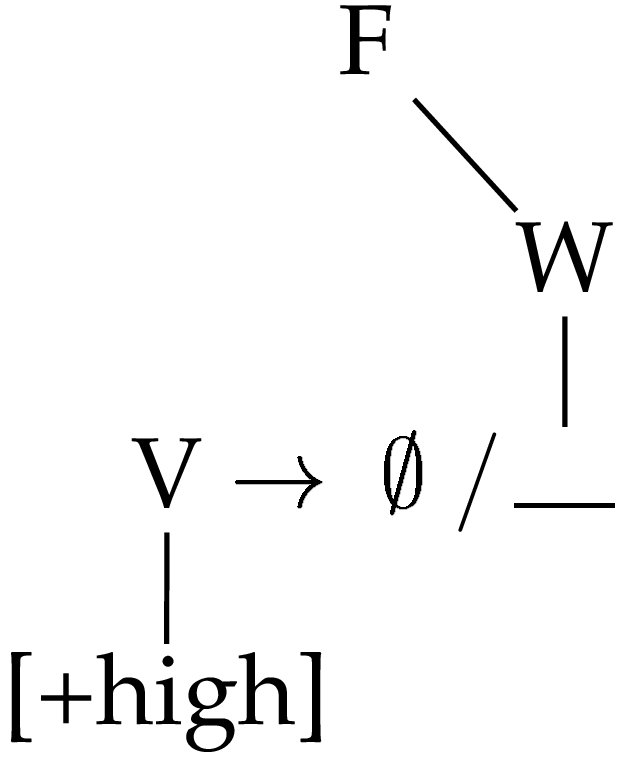 | b. | 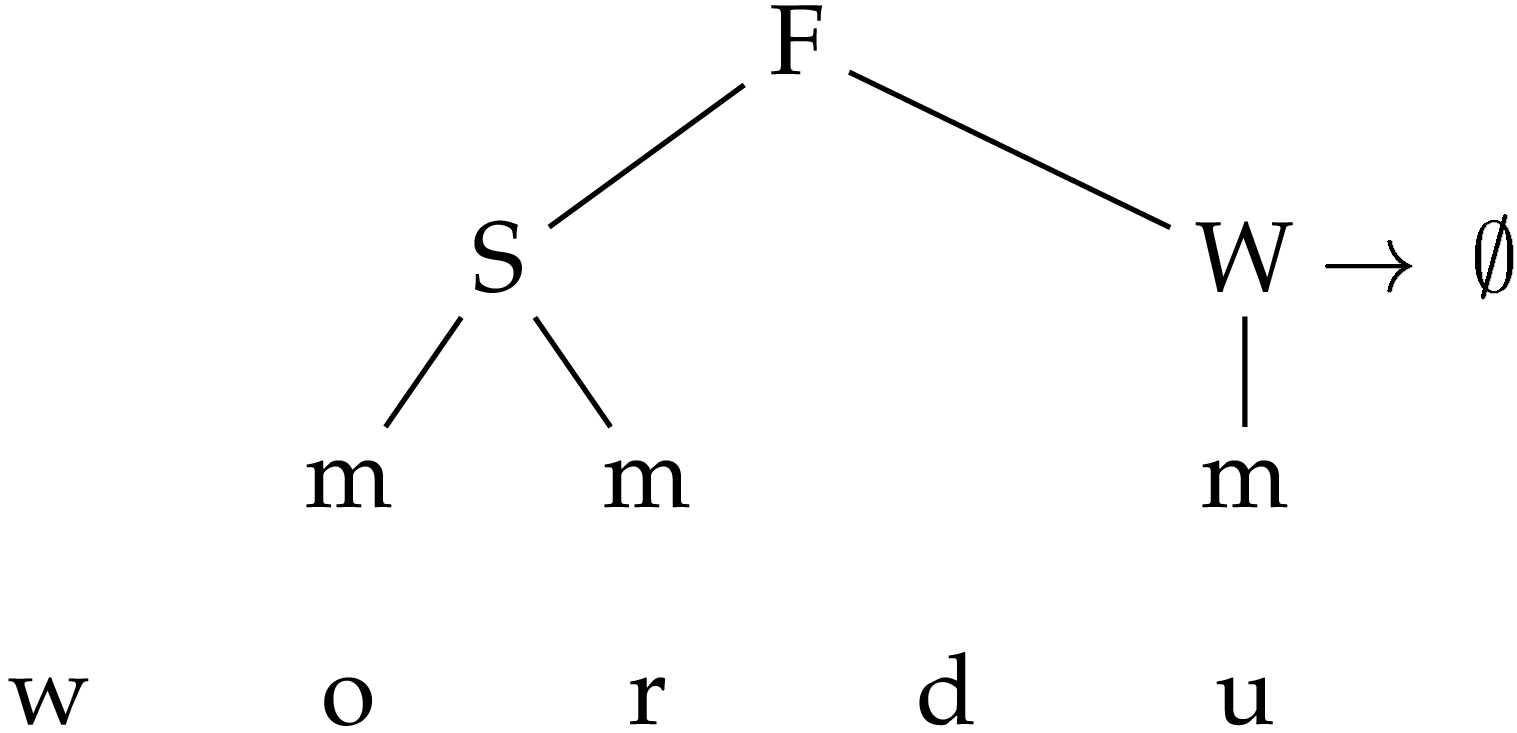 |
With F ‘foot’, S ‘strong’, W ‘weak’ and m ‘mora’, (2a) shows the original formulation of the foot-based approach to HVD. In other words, a metrically weak high vowel is deleted, as shown in (2b): *wordu☞Asterisked data (e.g., *wordu) show reconstructed forms, those with double asterisks (e.g., **werdes) ungrammatical forms. > word ‘word.nom/acc.pl’. Let us see a number of representations in (3), Dresher & Lahiri’s (8) and (9).
| a. | 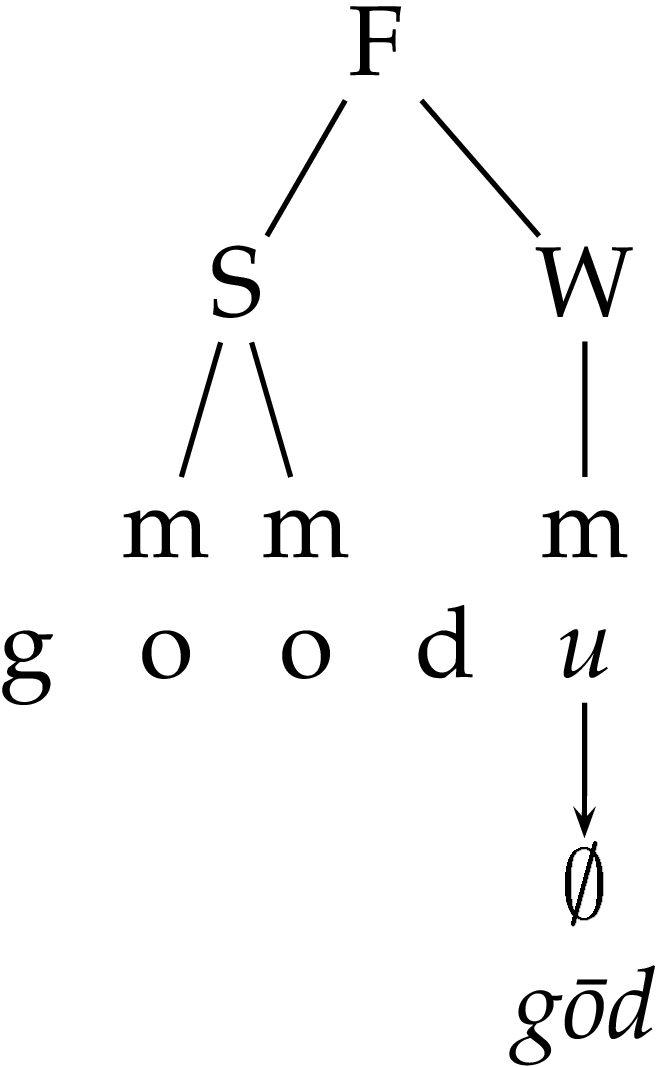 | b. | 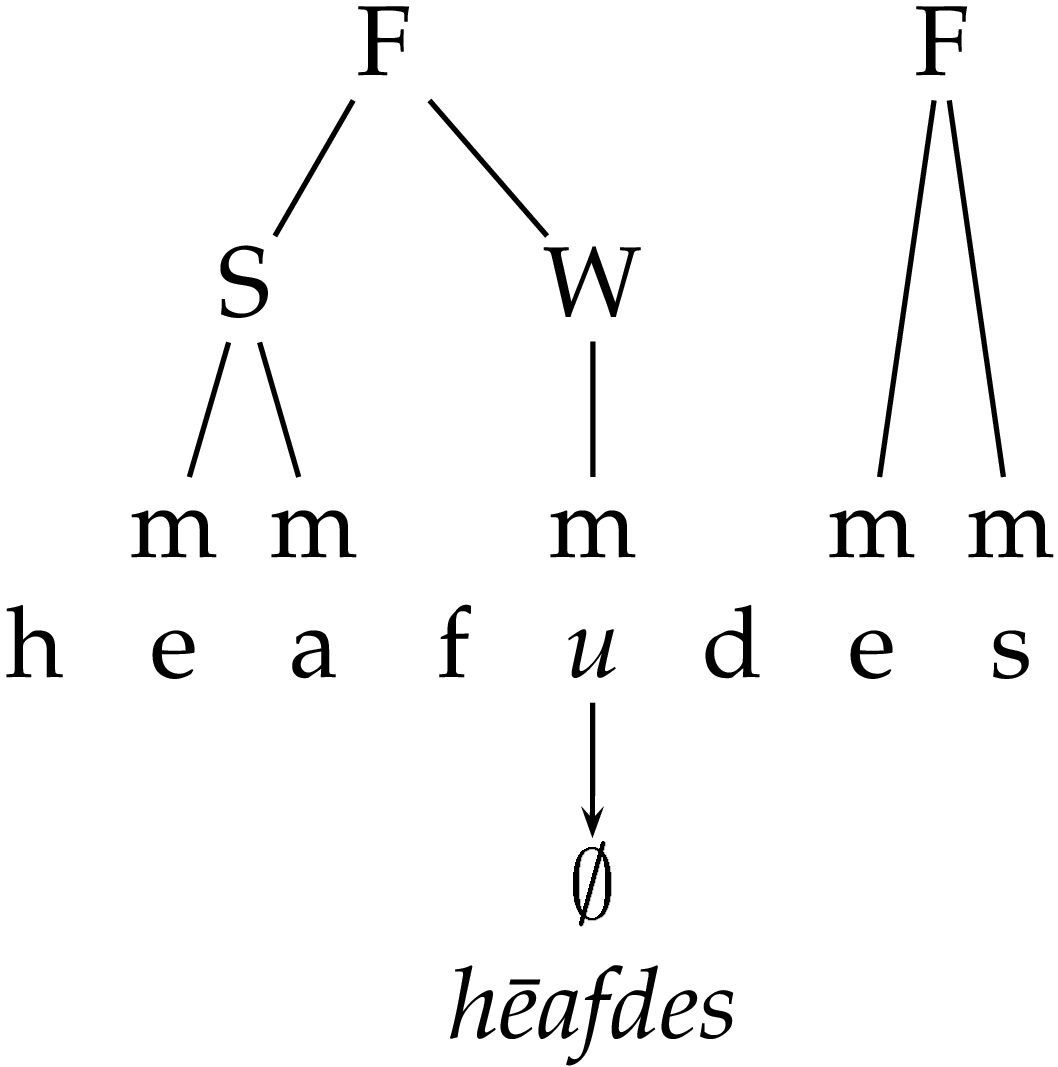 | c. | 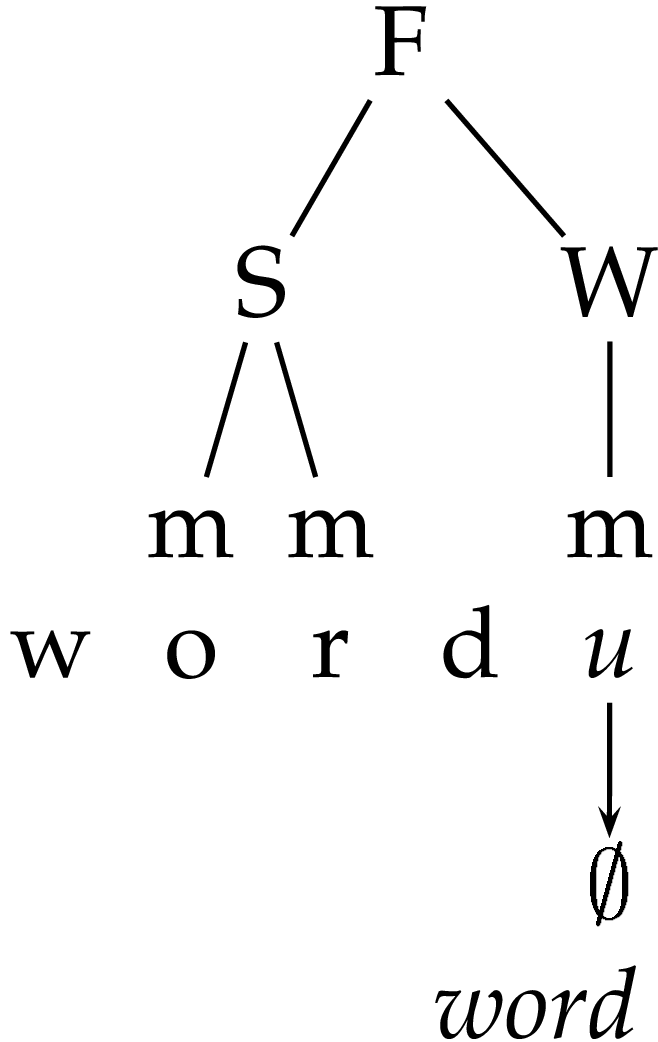 |
| d. | 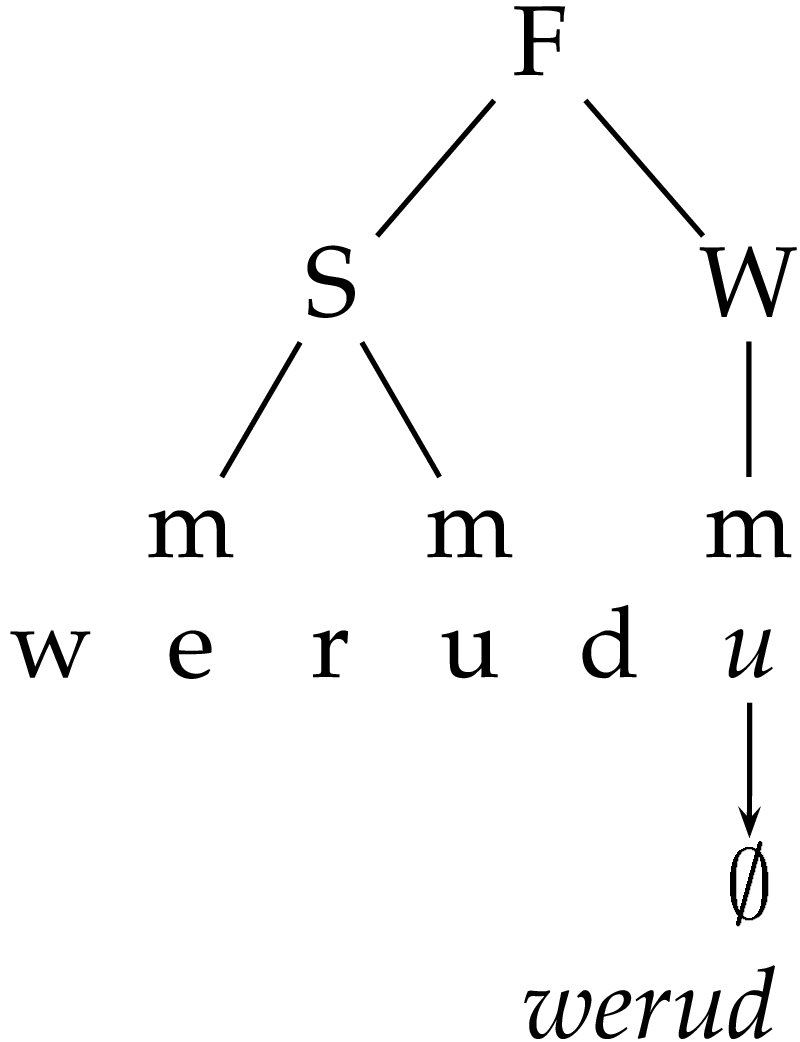 | e. |  |
In (3) the representations for gōd ‘good.nom/acc.pl’, hēafdes ‘head.gen.sg’, word ‘word.nom/acc.pl’, werud ‘troop.nom/acc.pl’ and lofu ‘praise.nom/acc.pl’ are given (with italicised
The Germanic foot, the authors claim, satisfactorily answers a number of issues in Germanic phonology:
Given the foot-based approach to HVD, it is no longer necessary to stipulate that the high vowels
The data in (3d), contrasted with (3a) and (3c), show that these structures are metrically equivalent as far as HVD is concerned. So, in order to build the strong branch of a foot, the mora of the next syllable must be recruited to satisfy the minimal two-mora requirement on weight of the strong branch of the foot.
Facts about HVD deletion obviously show that a heavy syllable was treated in the same way as the concatenation of a light plus either a light or a heavy syllable, so in some pre-theoretical sense the resolved foot does make sense (H = L X). This ushers in the notion of the “resolved foot” (or “resolved syllable”), a notion much criticised by Minkova & Stockwell (1994). They argue that structures like (3e) cannot be assigned any foot structure. However, Dresher & Lahiri (1991) do not claim that a foot must have a weak branch, so bimoraic and bisyllabic words like lofu must be assigned stress (and foot structure) by default, similarly to monosyllabic (and also minimally bimoraic) words like bæþ ‘bath’.
In Dresher & Lahiri’s (1991) conception the left branch of the Germanic foot is the “strong” branch of the construction: S could as well stand for ‘stressed’ and W for ‘unstressed’. When the left branch dominates heavy syllables, e.g.,
Theoretically, as argued in Minkova & Stockwell (1994) and Scheer & Szigetvári (2005), on different grounds, the stress imposing algorithm can designate one vowel only as stressed.☞The difference between Minkova & Stockwell (1994) and Scheer & Szigetvári (2005) is that while for the former the question does not arise which part of a long vowel is stressed (in *gṓdu the long vowel ō is stressed), for the latter (given the basic tenets of CV phonology) either the first or the second CV unit in a long vowel may be stressed (as is demonstrated for Ancient Greek accentuation). In Germanic, given that it is always the first vowel of the stem that receives stress, it must be the case that the same applies to a long vowel, i.e., it is the first CV unit (the first mora of the long vowel) that is stressed. Even if this were not so, there are no tests showing which CV unit of a long vowel or diphthong receives stress: so the difference between Germanic and OE ō1 /ˈoo/ and ō2 /oˈo/ must remain conjectural. Empirically, given the sound changes in OE, the second vowel of a resolved syllable cannot have been stressed. This is clear from the changes that affected the neuter a-stem nom/acc.pl
Let us take a closer look at the structure of wine, lofu and werud and try to ascertain whether “S” can mean anything else than ‘stressed’ (see (4)).
| a. | 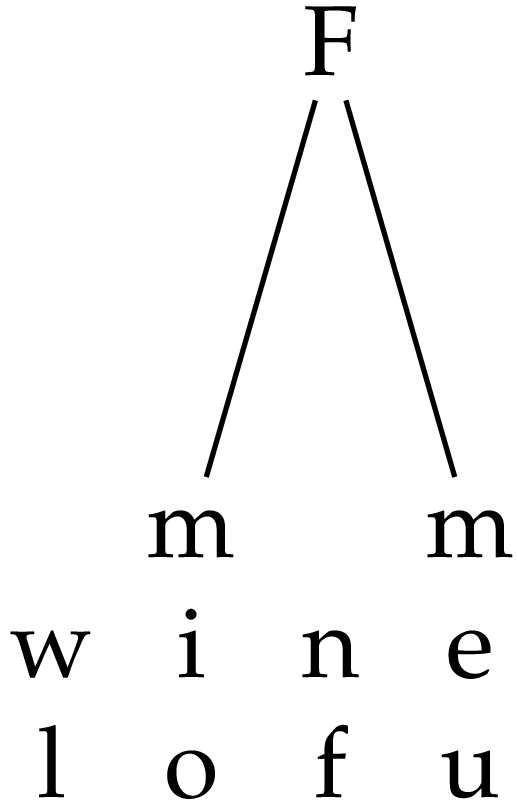 | b. | 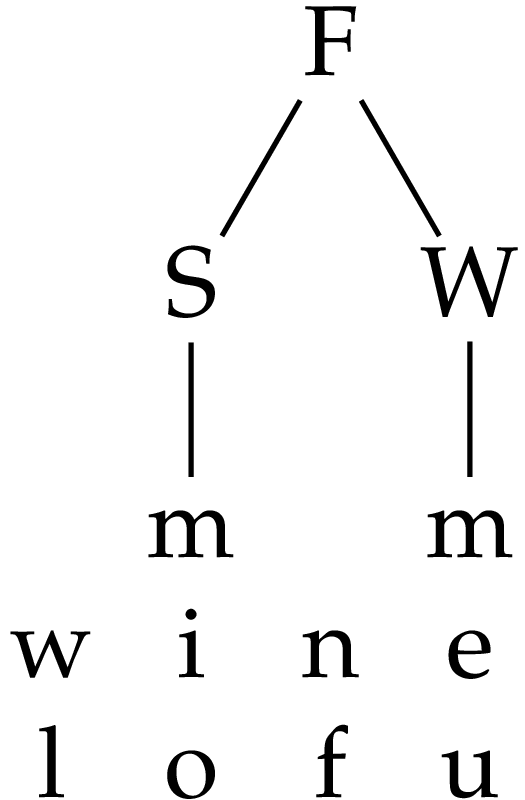 | c. | 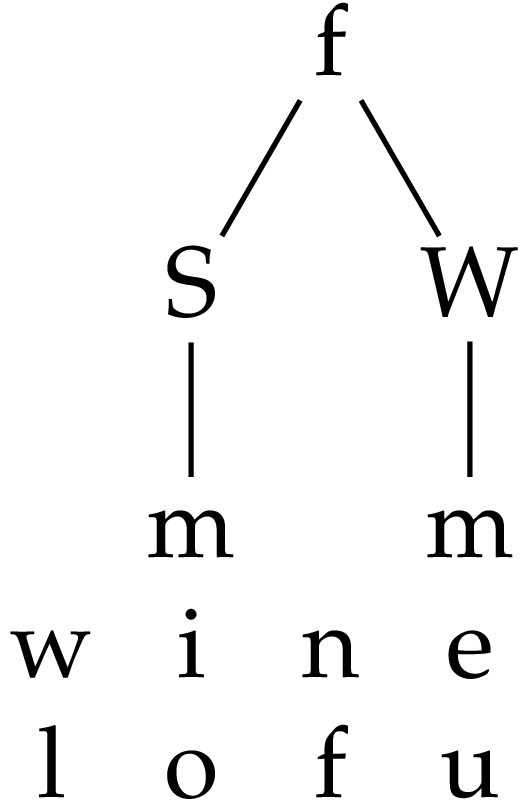 | d. | 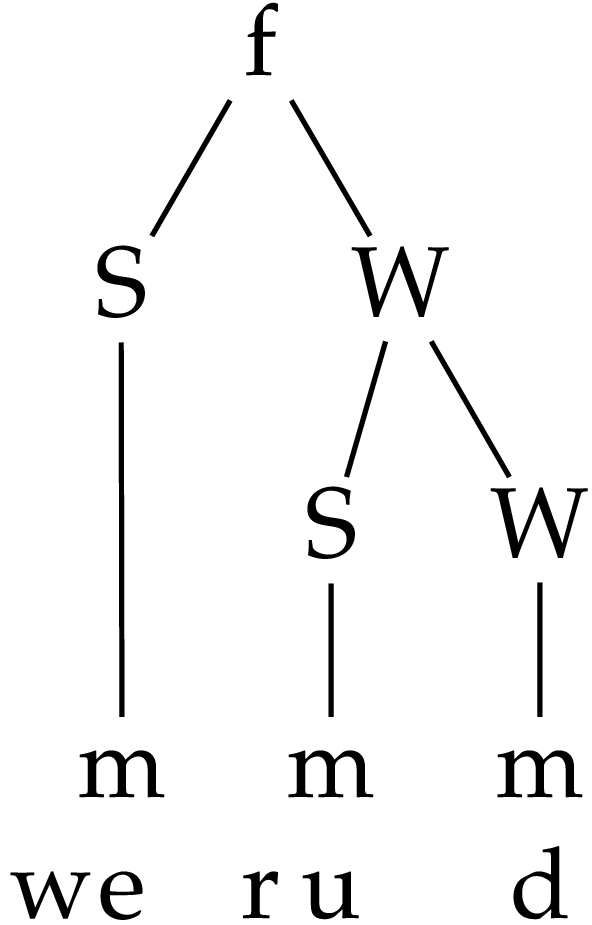 |
(4a) shows the representation of wine and lofu in the spirit of Dresher & Lahiri’s Germanic Foot. Here there is only one branch — given the formulation of the Germanic foot in (1) —, this can only be the strong branch of the foot (it must weigh at least two moras). Here the second mora comes from the second syllable. As it stands, (4a) can only be the representation of a stressed syllable (and a foot projected from it). This, however, entails that two vowels share the same stress, which is impossible. The problem would go unnoticed in case this single (strong) branch dominated a long vowel or a closed syllable with a short vowel. Imagine we attempt to revise this representation to the one in (4b). Here there is one stressed and one unstressed syllable (the first one is strong when compared to the syllable to its right, which must be weak/unstressed). However, (4b) cannot be the representation of the Germanic foot: the left/strong branch dominates one mora only. Realising this, after the discussion of Gothic data involving Sievers’ Law of j/ij alternation, Dresher & Lahiri (1991: 268) tackle the internal structure of the resolved syllable. The resolved syllable shown as f has the internal structure shown in (4c). This, again, is problematic because it is not clear at this point what the relationship is between F and f (obviously f is a constituent which is larger than a syllable, but smaller than a foot). In addition, the mystery constituent f is still strongly suggestive of shared stress.
In an attempt to save the Germanic foot, the authors suggest the structure shown in (4d), representing, for example, werud. This revised resolved constituent f fares better in one respect: it shows that stress is placed on one vowel only (the first vowel of the word). Yet, other problems emerge: first, the strong branch no longer dominates a minimum of two moras (as required in the original formulation). Second, the weak branch is now allowed to dominate two moras (again in apparent breach of the original formulation). Third, realising that the first two moras are somehow still the strong moras of the word, the authors employ another S, now inside the weak branch (they claim that it is “frozen” inside the weak branch). This S cannot be the same kind of S found on the stressed vowel, but their unity is emphasised by the notation (after all, two light syllables behave as a single heavy syllable from the point of view of HVD). The S inside W can mean a ‘strong mora’, as opposed to both a ‘stressed mora’ under S and a ‘weak mora’ (a W under W), but at this point the internal structure of the Germanic foot becomes incomprehensible. The constituent f projects into F. The unity of the two S nodes, as well as the “complete” Germanic foot should now take the following shape (see (5)).
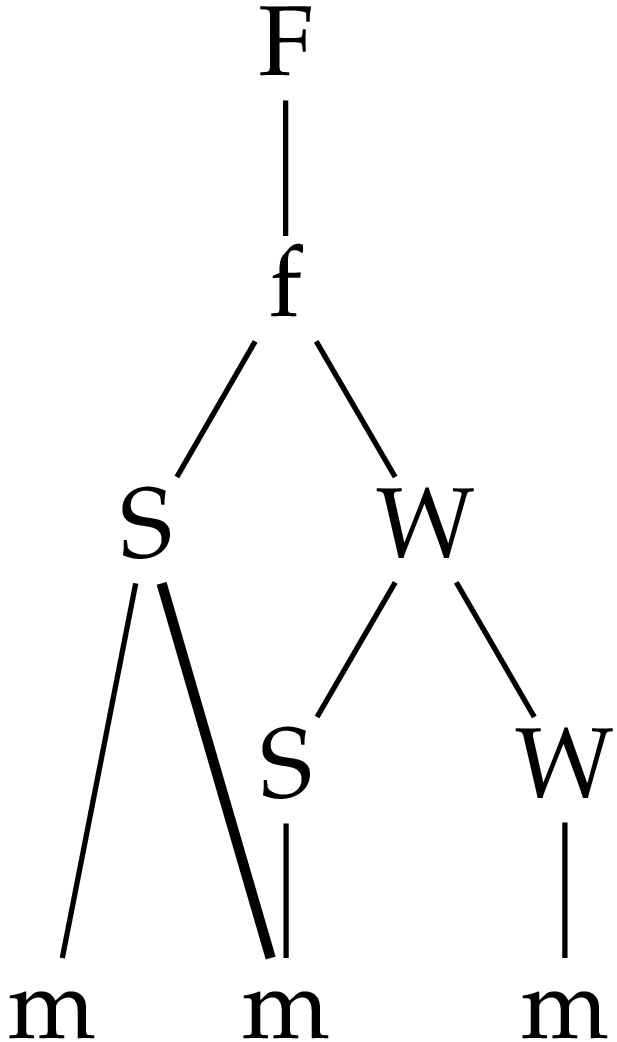
(5) summarises our discussion: f can only project into F, the Germanic foot. At this point, however, f and F become indistinguishable. The thick line shows the authors’ implicitly entertained idea that the (unstressed) S inside the weak branch behaves in tandem with the stressed S. This double linking of the weak S insures that the left branch of the foot still (somehow) dominates two moras. However, not even this can salvage the weak branch from dominating two moras. In addition, there is still no explanation for why syncope of the weak S is not allowed (werudes/**werdes ‘troop.gen.sg’). It is unstressed, so it could be potentially syncopated. The loss of the weak S would not impair the Germanic foot: its left branch would still dominate two moras (the second mora now provided by the coda consonant: **werdes).☞Germanic and, specifically, OE are not languages in which only pronounced vowels are visible for weight phenomena (which underlies the notion of HVD formulated in terms of the Germanic Foot): cf. Scheer & Szigetvári (2005, fn. 14) where stress computation in Ancient Greek is claimed to involve pronounced vowels only. Clearly, if OE were like Ancient Greek, both scipu and wordu would be well-formed (the left branch of the foot would dominate two pronounced vowels in this case). All in all, as (5) shows, the Germanic foot can certainly not be what the original formulation intends it to be.
Disregarding Dresher & Lahiri’s emendations to the Germanic foot in the form of the new constituent f, another problem is evident in their treatment of the H = L X equation (where X ranges over H and L). H in traditional terms can mean either ‘heavy by virtue of having a coda consonant’ or ‘heavy by containing a long vowel/diphthong’. All of the examples reviewed by Dresher & Lahiri involve the former type of heavy syllables in the weak branch (see (6a) below), but no example is given of a heavy syllable which contains a long vowel/diphthong (see (6b)).
| a. | 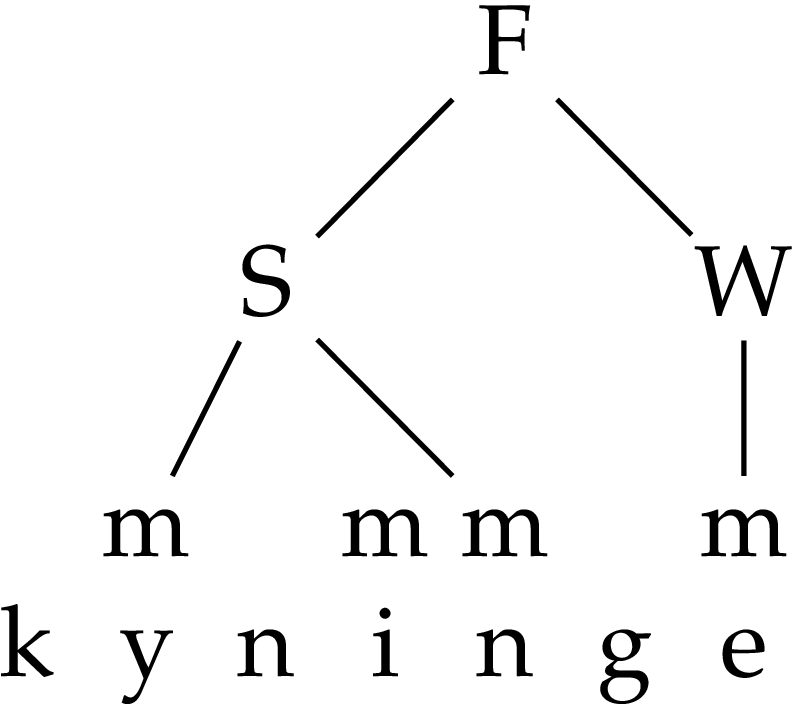 | b. | 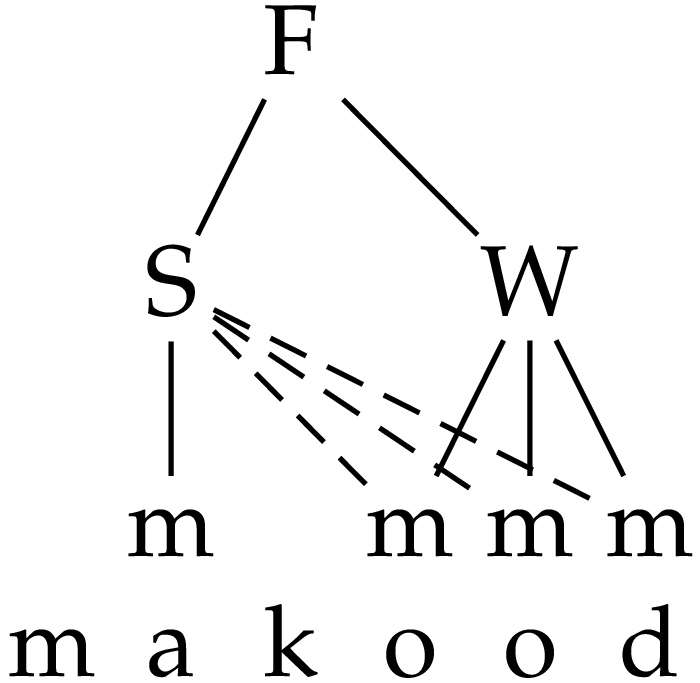 | c. |  |
The representation in (6a) shows pre-OE *kyninge ‘king.dat.sg’, (6b) and (6c) that of *makōd ‘make.pst.ptcp’. In (6a) the left/strong branch contains a minimum of two moras (the second vowel is recruited to supply the minimum requirement on moras).
In (6b) two representations are shown, one inside the other: the first (with the solid lines) shows the case when a long vowel is positioned in the weak branch (this is obviously impossible, given the formulation in (1): S cannot dominate a single mora). The parallel representation (with the dotted lines) shows the left branch taking all the moras. This is possible, given (1): the S node has to dominate at least two moras. As a matter of fact, this is the only grammatical parsing of this string. However, as discussed above, this representation also implicitly contains the notion of ‘shared stress’ (in this case three vowels would have to share it).
In any case, this is a no-win situation for the Germanic foot: in *mákṑde it cannot predict either primary stress (the strong branch, in the authors’ admission, has to dominate at least two moras to be able to designate the first mora as the strongest one) or secondary (the long vowel should also be included under the strong branch, given that it cannot be in the weak branch, but then it cannot be allocated stress, for which there is independent metrical and phonological evidence for early OE).☞Examples like the one shown in (6b) are not discussed by Dresher & Lahiri (1991) because they obviously hold the view asserted by Suphi (1988: 189) that long vowels and diphthongs do not occur in inflectional endings (though they are common in derivational suffixes). Although this claim may be true for late OE, it is certainly incorrect for pre-OE and early OE (and there are indications that some of the long vowels, e.g., past tense/past participle
The representation in (6c) shows yet a third possibility: the moras of the long vowel are split. The first mora is included in the strong branch of the foot for purposes of primary stress assignment.☞Implicit in the Germanic foot is that primary stress assignment is quantitative, i.e., only a heavy syllable can be stressed (if the first syllable is light, a second mora is recruited from the following syllable, leading to a resolved syllable). Stress assignment and weight have always been a controversial issue in OE phonology. McCully & Hogg (1990: 333) say that the first syllable of gúma ‘man’ is assigned stress despite its light status. If this could be proved for OE, in mácṑde secondary stress would be placed on the second mora of the long vowel (mákoòde). There is, however, no proof for secondary stress on the second mora of a long vowel (**mákoòde), nor is there proof for the bi-syllabic nature of such “long” vowels (máko$òde), but there is proof for the two moras of a long vowel behaving as a single unit. Put alternatively, if the moras of a (unitary) long vowel could be split, and the Germanic foot allowed to straddle two vowels (over the head of a consonant), the prediction is that a v̆́cv̅ sequence should behave as a single unit or at least not allowed to be split by a process. This is false, however, as shown by OE compounding (discussed below).
As a final remark on the Germanic foot, let us briefly see how it fits into the foot typologies proposed by Hayes (1980, 1985, 1987), Hammond (1984, 1986) and McCarthy & Prince (1986), Kager (2007), etc. OE is clearly a trochaic (head-initial) language (discussed in §4)☞Keyser & O’Neil (1985), however, argue for an iambic approach to OE prosody (including HVD). This is an extreme departure from OE (and Germanic) prosody where the overwhelming dominance of the leftmost syllable and the concomitant weakening of all other syllables seem to be beyond reasonable doubt. with primary stress assigned to the first vowel of the stem. Trochaic systems are divided into two types. The quantity-insensitive syllabic trochee requires two syllables of indiscriminate weight. The quantity-sensitive moraic trochee requires two moras: this is satisfied by either a heavy syllable of a sequence of two light syllables. Given the shortcomings of the Germanic foot as far as the issue of ‘shared stress’ is concerned, let us reformulate the Germanic foot along the lines of a syllabic trochee, so that it is now encompasses a stressed and an unstressed syllable (see (7)).
| a. | 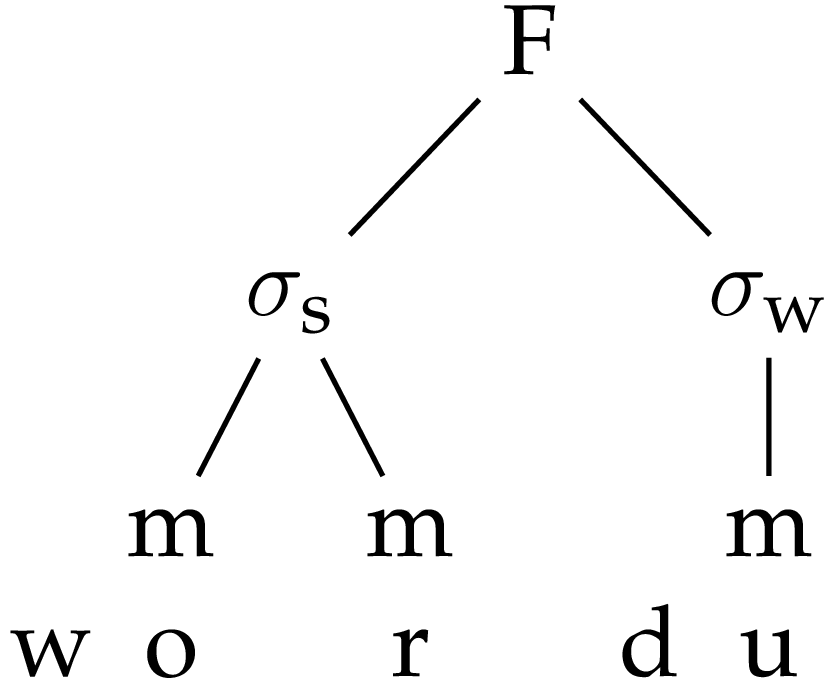 | b. | 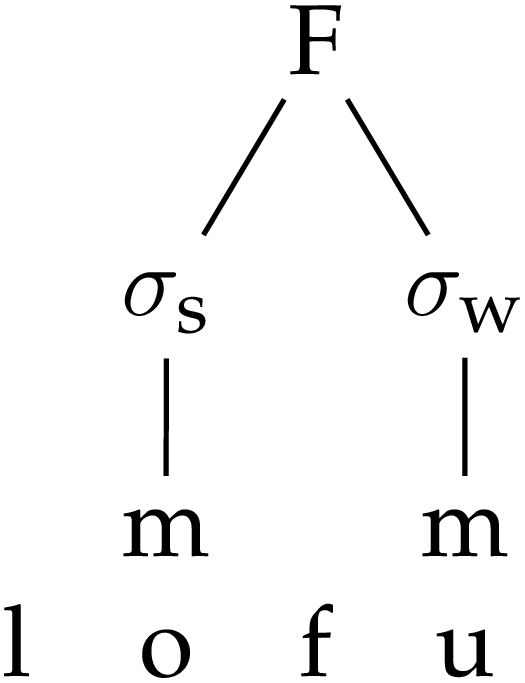 |
(7a) shows pre-OE *wordu, (7b) *lofu. These forms are found in OE as word and lofu. HVD cannot be formulated along the following lines: “delete a metrically weak (unstressed) vowel in a trochee”. This obviously works for (7a), but overgenerates in (7b) (here the weak syllable should also have been lost: **lof). There is no general well-formedness constraint ruling out **lof (cf. bæþ ‘bath’), so the answer must lie somewhere else.
The moraic trochee, on the other hand, would parse sequences with the pattern H L L as [H] [L L] in Cairene Arabic (e.g., Hayes 1987) with the first L heading a foot and receiving main stress. The Germanic foot, as Dresher & Lahiri (1991: 271) argue, would parse the same sequence as [H L] [L] with the first L being in the weak branch and subject to loss in case it contains a high vowel. A syllabic pattern L H L is parsed as [L H] [L] in OE, i.e., it has bounded feet and a light syllable is not skipped over by foot construction as opposed to Khalkha Mongolian in which only heavy syllables can receive stress with the light syllables remaining unfooted and later adjoined to the metrical word (e.g., Hayes 1980), see (8a) and (8b) below.
| a. | Khalkha Mongolian | b. | OE |
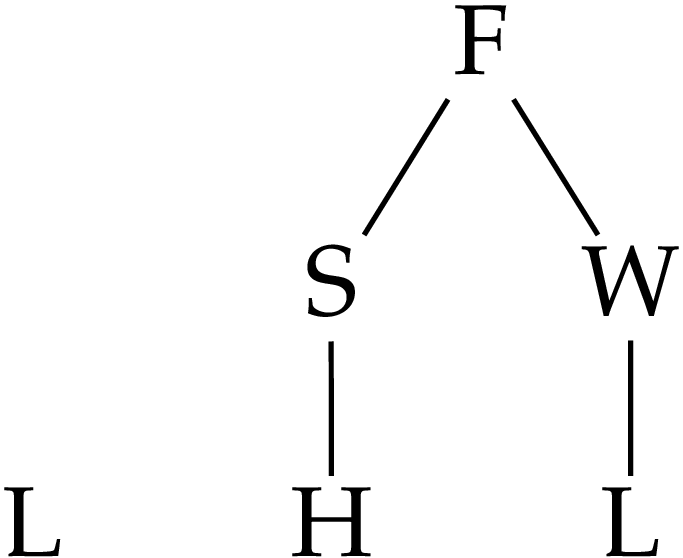 | 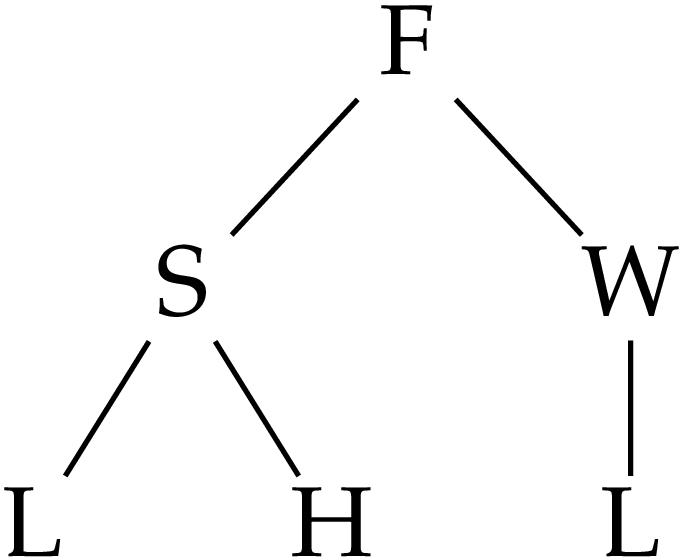 |
The requirement that the strong branch of the foot have at least two moras is reminiscent of Hayes’ (1980) obligatory branching (OB) parameter. The OB parameter, as applied to OE, means in essence that OE stress is quantity based. It also follows from (8b) that a heavy syllable following a light syllable can never be stressed (**mácṑde).
Dresher & Lahiri (1991: 272–279), essentially, develop the idea of the augmented (extended) moraic trochee whose left branch has to contain at least two moras and the right only a single mora. This leads to an “uneven” trochee.☞Kager (2007: 205f) discusses alternative (sometimes aberrant) foot types, one of which is the Germanic Foot. All in all, the problems presented by the analysis warrant a new discussion of some of the data that it draws on.
For our purposes, compounding will be taken informally to involve A and B to yield AB. Before a rule is attempted, some examples are supplied in (9). Truncation is shown as “✂”.
There are three vowels that can appear in word-final position: the high vowel 〈u/o〉 (most probably /u/), a mid vowel 〈e〉 (generally assumed to be /ə/, at least in late OE) and a low vowel 〈a〉 (/ɑ/). A generalisation on truncation is difficult is reach. One cannot say that truncation happens along the division line of consonants and vowels, nor can one say that truncation happens on the basis of vowel quality: the mid vowel 〈e〉 is split along lines that are difficult to grasp. Syllable weight is of no help either:
We may take the etymological (pre-OE) length of word-final inflectional vowels into consideration: *endī, *kwenō(n), *gumā, etc. We might say that long vowels are always preserved in OE (ende, cwene, guma) and truncated in compounding. This does not explain ende, which escapes truncation in compounding. What is more, if we suppose on the basis of OE that long vowels survive into OE, we are forced to conclude that wini and medu had long final vowels (*winī, *medū), but this is incorrect etymologically (**winī, **medū). These words had short vowels in pre-OE: *wini, *medu. Of course, one may hasten to add that it is equally possible that there was a change that lengthened word-final short high vowels at some point in pre-OE (*wini > *winī, *medu > *medū, *wordō > *wordo > *wordu > *wordū), which prevented HVD. Such long vowels (given that they weigh two moras) would be placed in the strong branch of the Germanic Foot. This is possible, but it dodges at least two technical questions: (i) the first/strong foot of *winī containing the short vowel should be impossible according to the Germanic Foot (it must be heavier than a single mora according to the original formulation) and (ii) it dodges the question of why such long high vowels were lost after heavy syllables (?*wordū > word), but not after light syllables (?*winī > wine). This latter problem shows that some weak heavy feet were lost (?*wordū > word), some not (?*winī > wine). The problems in (i) and (ii) are entwined.
What is more, the Germanic Foot predicts that guma, wine, cwene, medu should behave in the same way (as opposed to ende, ēage, steorra, wīte). Recall: the Germanic Foot treats guma, wine, cwene, medu, etc. as a constituent. At least two moras are needed for the strong (left) branch of the foot. These moras can be recruited from two consecutive vowels straddling a singleton consonant (guma, wine, etc.). The Germanic Foot predicts that guma and wine should behave identically (neither should lose its final vowel in compounding). What is more, the account also predicts that, once a word-final vowel should be lost in a process, the final vowel in ende, wīte, etc. should be more prone to lose their vowels vis-à-vis the line of demarcation predicted by the Germanic Foot (the foot that would remain after truncation of the weak branch of the foot is heavy:
The counterargument may be that the Germanic Foot was set up to account for a phonological phenomenon, and thus compounding falls outside its scope. This is true, but using a generalisation at more than one point in one’s analysis makes that generalisation more appealing. Compounding obviously cannot be explained drawing on the insights of the Germanic Foot.
Bliss (1967: §37, app. §4), Kuryłowicz (1948/1949, 1970) and Suzuki (1996) note that morphological identity among the words involved in alternations sensitive to HVD may have given rise to the equivalence between morphologically comparable words with and without an overt ending, e.g., hof ‘enclosure’ = word, gifu ‘gift’ = gūð ‘combat’. Suzuki (1996) claims that *i/*u were reanalysed as part of the stem, rather than a suffix, as they originally were: e.g., wine < *win-i ‘friend’, rather than win-e and, similarly, gif-u (< *gif-ō), reanalysed as gifu. The equation H = L X (where X ranges over a H or a L syllable) is known as resolution. Resolution is claimed to exist in OE poetry, but its presence in phonology is more contentious (see discussion on “shared” stress above). He gives some support for this interpretation:
Suzuki’s claim may have been applicable to pre-OE when the vowel of wine was still a high vowel (*wini), but it is difficult to see how this was to play out in recorded OE, by which time the vowel 〈e〉 was probably reduced to /ə/ (Hogg 1992). The data show that words ending in 〈e〉 are treated differently (compare cwene to wine, of which only the first one is truncated when compounded). It may be argued that compounds involving cwene, wine, medu, etc. became lexicalised at some point, but the process seems too regular. Perhaps the claim that all inflectional suffixes had been shortened by recorded OE is too hasty. Let us look at the conditions under which word-final vowels survive into OE.
Here a synchronic account will have to be made on the basis of inferred diachronic data. I will tackle some of the major points. Fulk (1992) follows Kaluza’s (1896) insight in viewing short vowels as descending from proto-Germanic plain vowels, and the long ones as those of the circumflected ones (traditionally called trimoraic):☞Kaluza (1906: §73 (h)) claims that original Germanic stressed circumflected (G. schleifend) trimoraic vowels changed to stressed bimoraic vowels with a so-called normal intonation (G. gestoßen) in OE. Although Kaluza makes no difference at this point between primary and secondary stress, these vowels must be secondary stressed (they all occur in inflectional endings). e.g.,
Fulk (2002: 336) adds another category to the “long endings”: all inflections ending in a consonant. Bliss (1967) and, more recently, Suzuki (1995, 1996) classify long vowels as those that remain after heavy syllables by OE times. Consequently, all of those vowels that are lost after heavy syllables are short. This may leave a synchronic alternation between
As can be seen, both accounts are synchronically opaque:
The question that arises naturally with the deletion of short vowels is why only the high vowels were affected. A solution usually offered (also by Suzuki 1996: 305) is that the distinction between the high vowels and the rest of the vowels rest on a minimal degree of sonority in pre-OE *i and *u, as opposed to the rest of the vowels. Although a more substantial analysis is impossible here, the reason for the deletion of the two high vowels is simply due to a diachronic coincidence: at the point when HVD operated, these two vowels were the only short word-final vowels. There were other short vowels, but these were not word-final (e.g., beran/rīdan ‘to bear/ride’ < *beranam/*reidanam, boren/riden ‘born/ridden’ < *boranaz/*ridanaz, Campbell 1959: §333f).
The deletion of the Germanic vowels in word-final position is not invariably linked to sonority. This is supported by the deletion of
As a matter of fact, it is the high vowels that are most resistant to deletion from a diachronic perspective. In connection with guman < *gumani, Campbell (1959: §331 (3)) remarks that
Later sound changes brought about the shortening of the word-final long vowels. The long vowels that were saved from deletion are
The long vowels (after shortening and possibly rising in the case of the back vowel) could only be saved from deletion if they were preceded by a light syllable. If not, they were lost: word < *wordu < *wordo < *wordō, bend < bendu < *bendju (after syncopation) < *bendiju < *bendijō (by Sievers’ Law) < *bandjō. The rest of the pre-OE vowels at the time of HVD were long (most probably only long monophthongs survive by this time) and thus undeletable, see (10).
| pre-OE | (early) recorded OE | |
|---|---|---|
| a. | *skipu | scipu ‘ships.nom/acc.pl’ |
| b. | *wini | wine ‘friend.nom.sg’ |
| c. | *dǣdī | dǣdi > dǣde ‘deed.nom.pl’ |
| d. | *endī (?*endij) | endi > ende ‘end.nom.sg’ |
| e. | *fremidǣ | fremede ‘save.1sg.pst.ind’ |
| f. | *skipǣ | scipæ > scipe ‘ship.dat.sg’ |
| g. | *gumā | guma ‘man.nom.sg’ |
| h. | *lāru | lār ‘learning.nom.sg’ |
| i. | *tēþi | tēþ ‘tooth.nom.pl’ |
(10) offers some examples for pre-OE word-final short vowels that survive if they were preceded by a light syllable; if not, they are deleted (compare (10a) and (10b) to (10h) and (10i)). In case the word-final vowel was long, it was retained. The chronology of the shortening and monophthongsation processes of the various vowels cannot be undertaken here but Campbell (1959: ch. VII) offers a comprehensive summary. All in all, it seems that vowel deletion after certain contexts is formulated as HVD because the only two eligible word-final short vowels at the time of the activation of HVD were *i and *u. This is a diachronic coincidence. We have now looked at what etymology can tell us about word-final vowels. Let us now see what compounding can tell us about vowel-final words.
Etymological length of vowels is one side of the issue. The other is what morphology can tell us about vowel length. We have seen that truncation cannot proceed either along the etymological structure of words into stem + inflectional ending (compare
There is one remaining avenue open for us: distinctive vowel length in inflectional vowels. All inflectional vowels are unstressed. Distinctive vowel length in unstressed syllables has generally been assumed for derivational suffixes only (e.g., mán(n)hād ‘manhood-nom.sg’), even for late OE. It is also assumed that long-vowelled syllables of derivational suffixes can be secondary (or possibly tertiary) stressed if followed by a vowel (e.g., mán(n)ha᷅des gen.sg).
A slightly different scenario is assumed for inflectional suffixes (at least for late OE). A historically long-vowelled suffix is assumed to have a short vowel, exemplified here with the formative vowel of the second class of past tense/participle forms (e.g, lṓcŏd ‘lock.pst.ptcp’, historically
Word-final inflectional vowels are difficult to test for length or stress. A final inflectional vowel, in, e.g., heort-e, is always final, no other vowel can follow it (e.g., **héortḕa). This is how the length of such vowels can remain obscure. It seems, however, that morphology can be of help here: morphology was sensitive to length differences that remained hidden by spelling or impenetrable to phonological tests. Let us formulate our rule for OE compounding in (11).
If we accept (11) and work backwards, as it were, we can now supply the missing disambiguating length marks on the final vowels of the examples in (9), see (12).
The disambiguated vowels in (12) only show reconstructed quantity, but tell us nothing about quality. This reconstruction is probably true for classical or at least non-late OE. If we go by the spelling, it seems that in word-final position in this period there is no short or long 〈i〉, no long 〈u〉 for the high vowels, only long 〈a〉 exists for the low vowels and both long and short 〈e〉 for the (presumably) front (and/or central) mid region. It is equally possible that short 〈u〉 was actually a short 〈o〉 (with 〈o〉 usually being treated an as allograph of 〈u〉). This in turn means that there were no unstressed high vowels in word final position in inflectional endings.
Note, however, that there is one more surprise at the end of vowel-final words: ende does not undergo truncation (endelēaf), contrary to our expectations (**endlēaf). Let us look at some etymological considerations. The word belongs to ja-stem nouns: *andjas > *andijas (through Sievers’ Law: *j is found as *ij after heavy syllables). The *i was responsible for umlaut (*a > e). There is some controversy over what the pre-OE form of the word was (e.g., Campbell 1959, Hogg 1992): *andij or *andī. What is certain is that it cannot have been *andi (*endi after umlaut) because word-final *i would have been deleted by HVD (**end). We can also say for certain that it cannot have been *andī (at least not at the time of umlaut) because long *ī does not cause umlaut. Still, *ij may have undergone monophthongisation to *ī after umlaut: *andij > *endij > *endī. We must, however, discard the possibility of *endij surviving into OE. One piece of evidence comes from spelling: endij is expected to have been spelt endiġ. The other is phonological: in OE there was no general monophthongisation of ij 〈iġ〉 to a vowel spelt 〈e〉 (e.g., īfiġ ‘ivy’, **īfe). We must conclude therefore that ende must have been *endij: (i) the high front vowel was short and thus capable of causing umlaut, (ii) it was not lost to HVD because it was not word-final, (iii) *ij must have undergone monophthongisation to *ī before the first written evidence appears and (iv) *ī must have undergone shortening to *i (ende is found with word-final 〈i〉 in very early manuscripts: endi), which later changed to a vowel spelt 〈e〉 in classical OE. The shortening of *ī to *i and HVD were in a counter-bleeding relationship (the shortening comes too late, as it were, for endi to undergo HVD). Compounding treats ende identically to wine and medu. All this evidence triangulates pre-OE *endij/*endī as OE endĕ. We can now augment (12), shown in (13).
This gives us the following word-final unstressed vowels for OE: ŭ (or ŏ), ĕ, ē and ā. We must reject Suphi’s (1988) claim that there was no quantitative distinction in inflectional vowels. Phonology and morphology treat them differently, so they must be different. The quality of the vowels shown as 〈e〉 must remain conjectural.
If a compound is informally taken as involving the concatenation of two words, A and B, to yield AB, the A part of AB undergoes truncation before the final vowel if this vowel is long (e.g., gum- from gumā, heort- from heortē). If the final vowel is short, there is no truncation of the final vowel (e.g., winĕ, wudŭ, endĕ). Remaining within a foot-based approach, this shows that while mora sharing between two short vowels over the head of a single consonant is possible (winĕ), mora sharing between a short and a long vowel is impossible (**gumā), in violation of the predictions made by the Germanic Foot. The Germanic Foot predicts that for resolution (H = L X) X can be either light or heavy. The heaviness of the syllable shown as X can be due to a coda consonant (e.g., hæsel) or a long vowel (e.g., gumā). This seems to be hasty. The long vowels should be taken out of the equation (at least for non-late OE). We have also been able to disambiguate word-final inflectional vowels from the point of view of quantity.
Bliss, Alan Joseph. 1967. The Metre of Beowulf (2nd ed.). Oxford: Basil Blackwell.
Campbell, Alistair. 1959. Old English grammar. Oxford: Clarendon Press.
Dresher Bezalel Elan and Aditi Lahiri. 1991. The Germanic Foot: metrical coherence in Old English. Linguistic Inquiry 22: 251–286.
Fulk, Robert Dennis. 1992. The history of Old English meter. Philadelphia: University of Pennsylvania Press.
Fulk, Robert Dennis. 2002. Early Middle English evidence for Old English meter: resolution in Poema Morale. Journal of Germanic Linguistics 14: 331–355.
Hammond, Michael. 1984. Constraining metrical theory: a modular theory of rhythm and destressing. PhD dissertation, UCLA, Los Angeles.
Hammond, Michael. 1986. The obligatory-branching parameter in metrical theory. Natural Language and Linguistic Theory 4: 185–228.
Hayes, Bruce. 1987. A revised parametric metrical theory. Proceedings of the North Eastern Linguistics Society 17, vol. 1, Graduate Linguistic Student Association. Amherst: University of Massachusetts.
Hayes, Bruce. 1980. A metrical theory of stress rules. PhD dissertation. Cambridge, Mass: The MIT Press.
Hayes, Bruce. 1985. Iambic and trochaic rhythm in stress rules. Proceedings of the Berkeley Linguistics Society 11: 429–446.
Hogg, Richard Milne. 1992. A Grammar of Old English (Volume 1: Phonology). Oxford: Blackwell.
Kager, René. 2007. Feet and metrical stress. In: Paul de Lacy (ed.). The Cambridge handbook of phonology. Cambridge: Cambridge University Press. 195–228.
Kaluza, Max. 1896. Zur Betonungs- und Verslehre des Altenglischen. Festschrift zum siebzigsten Geburtstage Oskar Schade. Königsberg: Hartung. 101–134.
Kaluza, Max. 1906. Historische Grammatik der englischen Sprache, 1. Teil. Berlin-Schöneberg: Verlag von Emil Felber.
Keyser, Samuel J. and Wayne O’Neil. 1985. Rule generalization and opacity in language change. Dordrecht: Foris.
Kuryłowicz, Jerzy. 1948/1949. Latin and Germanic metre. English and Germanic Studies 2: 34–38.
Kuryłowicz, Jerzy. 1949. La nature des proces dits ‘analogique’. Acta Linguistica 5: 15–37.
Kuryłowicz, Jerzy. 1970. Die sprachlichen Grundlagen der altgermanischen Metrik. Innsbrucker Beiträge zur Sprachwissenschaft, Vorträge, Band 1. 1–23.
McCarthy, John J. and Alan Prince. 1986. Prosodic Morphology Ms, University of Massachusetts and Brandeis University.
McCully, Chris B. and Richard Milne Hogg. 1990. An account of Old English stress. Journal of Linguistics 26: 315–339.
Minkova, Donka and Robert Peter Stockwell. 1994. Syllable weight, prosody, and meter in Old English. Diachronica XI/1: 35–64.
Scheer, Tobias and Péter Szigetvári. 2005. Unified representation for stress and the syllable. Phonology 22: 37–75.
Starčević, Attila. 2009. Middle English Quantitative Changes. PhD Dissertation, Eötvös Loránd University, Budapest.
Suphi, Menekse. 1988. Old English stress assignment. Lingua 75: 171–202.
Suzuki, Seiichi. 1995. In defense of resolution as a metrical principle in the meter of Beowulf. English Studies 76: 20–33.
Suzuki, Seiichi. 1996. Preference conditions for resolution in the meter of Beowulf: Kaluza’s Law reconsidered. Modern Philology 93: 281–306.